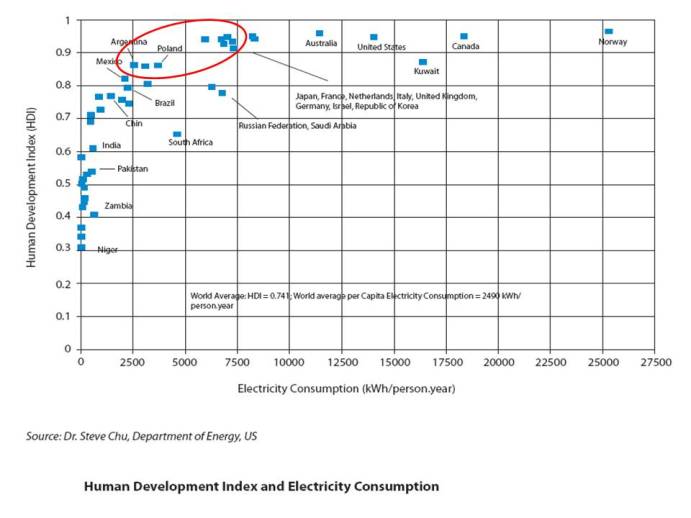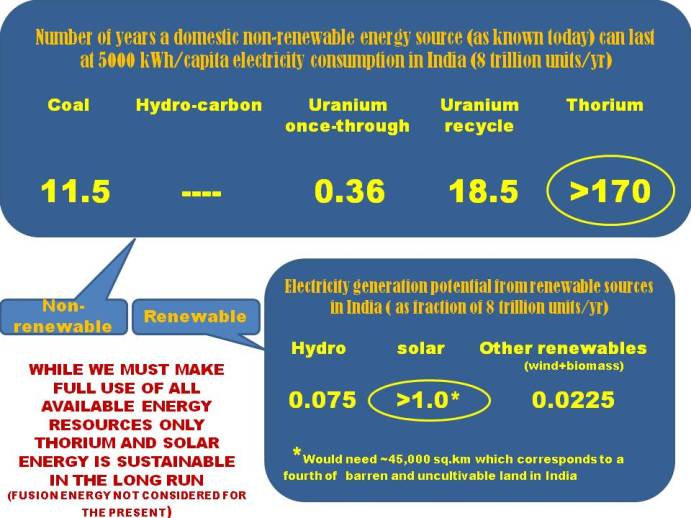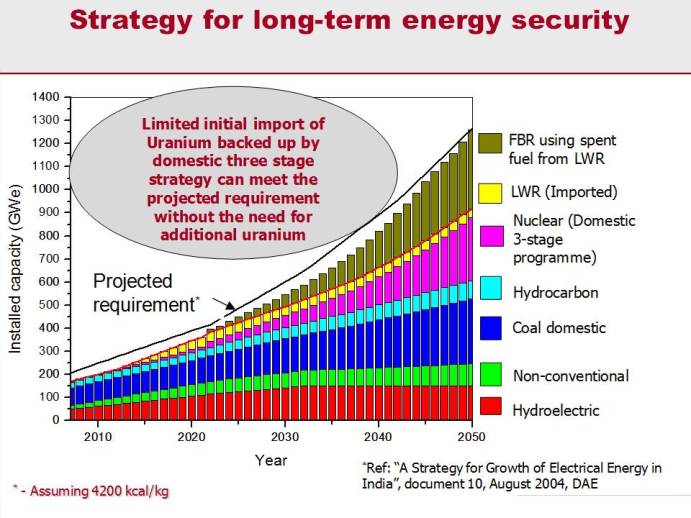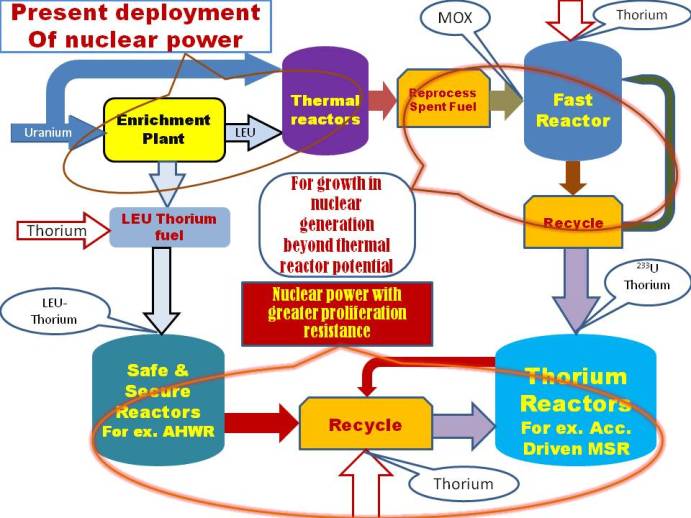
|
NUCLEAR ENERGY
|
RELATED ARTICLES
|
|
|
Nuclear Energy is inevitable
A quick look at Fig. 1 would suggest that we need around 5000 kWh/capita of electricity annually to reach a respectable human development index in our country. Being based on global statistics, in today's highly interconnected and interdependent world, we can surely depend on this number as a bench mark that we must achieve. Our current per capita electricity use is however a factor of seven lower. Unfortunately our population is also growing. Indications are that, we are likely to stabilize around 1.6 to 1.8 billion people. We thus need to secure energy resources and technologies to harness them at a level ten times larger than what we have at present.
 Fig.1
Additional electricity that we need on this basis would roughly correspond to 40% of today's global electricity generation. In a situation of depleting world energy resources and thrust to cut down on carbon-di-oxide emission, such large energy demand on a sustained basis clearly has global ramifications and attendant constraints, particularly since our domestic energy resource base, except Thorium and Solar energy, is highly inadequate in the context of energy needs projected above. (see Fig.2)  Fig.2
Clearly we need to focus our attention on nuclear and solar energy with a degree of high priority. Background to Nuclear Energy development in India
In India we have been pursuing development of nuclear energy right since the beginning. Given our known endowment of very modest Uranium and vast Thorium resources, we have pursued a three stage technology development programme that would enable us to exploit our Thorium resources on a large enough scale. As it is, Thorium can't be readily fissioned to release nuclear energy. It can however be converted to fissionable form and then used for energy production. However the scale at which we can get energy from Thorium depends on the cumulative capacity of uranium based nuclear reactors that can be deployed for conversion of Thorium to fissionable form. Since the only fissionable material available in the nature is Uranium 235 which is a small fraction of natural Uranium, any nuclear energy programme has to necessarily begin with Uranium reactors. Further since the growth of power generation capacity with a given limited quantity of Uranium, a situation in which we are in, can take place only with Fast Breeder Reactors, the objective of unleashing energy potential of our Thorium resources on a large enough scale necessarily requires sequential implementation of Uranium reactors to start with in the first stage and Fast Breeder Reactors that multiply power generation capacity without needing additional mined Uranium in the second stage before the final third stage of Thorium reactors can be launched on a scale commensurate with our long term electricity generation needs as spelt out in the beginning of this article. As is clear from Fig.2, one fourth of the barren and uncultivable land in India (which would correspond to around 45,000 sq. kM) should be sufficient to collect solar energy to meet all our needs. Thus in addition to tapping solar energy where ever there is an opportunity without any land use conflict, one would need to develop technologies appropriate for large scale deployment in barren uncultivable areas away from populated regions. Clearly this development involves development of a number of technologies related to nuclear reactors and associated fuel cycles. We had to necessarily follow this path in contrast with most other countries which pursued nuclear power programmes based on thermal reactors alone and that too in most cases without needing to pursue the back end of the fuel cycle. These countries could adopt that path since they had no difficulty in accessing Uranium in any amount. For us, with our modest Uranium resources and long term interest in Thorium, we necessarily required reprocessing and recycle option and sensitivity associated with these technologies in the context of their closer linkage with nuclear weapons, was bound to create restrictions in nuclear transfers to India. With India forced to exercise its nuclear weapons option to ensure her own security, the restrictions became more severe. Notwithstanding international restrictions, we succeeded in taking the first stage to commercially competitive level consistent with global benchmarks, became a leading country in Fast Breeder Technology with 500 MWe commercial prototype fast breeder reactor (PFBR) at an advanced level of construction and a unique country that has a live programme on all aspects of Thorium technology with a small reactor that runs on Uranium 233, a fissile material derived from Thorium. This self reliant development within the country, well poised for rapid progress towards the end objective of large scale use of Thorium for energy production, was implemented fully in keeping with complete adherence to obligations that we had accepted. We thus became known as a responsible country with advanced nuclear technology. Our nuclear weapons capability was already demonstrated earlier. With a rather rapid economic growth in India, the demand for electricity started rising at a fast pace. Several studies have shown sustained growth in our economy over 4-5 decades. Naturally then, India would need energy on a large scale to support her growing economy and improve the human development Index to the best level possible. Given the scale of energy required for this purpose as stated in the beginning, India came to be seen as a large energy market that could have a major escalatory impact on prices of fossil energy. This was also the time of heightened sensitivity about the threat to global climate as a result of increased use of fossil energy. Exploiting Indian energy market through nuclear energy thus started appearing to be an attractive proposition since India any way had graduated in nuclear technology terms and geo-politically was never a threat to major nuclear vendors rather this also presented an opportunity to develop greater strategic balance in the region. This was also the time when, while in technological terms, we had made important strides, the programme was far short of meeting national expectations in energy terms which were becoming rather critical in the context of growing economy. While our reactors were creating new performance bench marks, they started suffering loss of capacity on account of Uranium supply shortages. While work on several new mines was initiated, it would take a while before they produced results. Aggressive investments were also made in bringing in new technologies for exploration such as TDEM survey instruments, electro-hydraulic drills etc. This however would take even longer time to deliver Uranium. At a time when we were technologically ready and national expectations on electricity supply were high, non availability of Uranium was letting us down. The best we could do was to reconfigure reactors to work at a lower power with much greater Uranium use efficiency, so that NPCIL could sustain without making losses till Uranium supply situation improved and simultaneously pursue various avenues to a lasting solution to the problem of assured Uranium supply for our present and future nuclear reactors. A long term assessment also revealed that about 25% gap would persist between electricity supply and demand despite the most optimistic performance of all electricity generation options including the domestic three stage nuclear power programme. The only way the gap could be bridged was through import of energy. Of all choices for import of energy, import of Uranium would have several advantages. As it is the quantity involved would be very small. More importantly, since we were to any way pursue Uranium recycle in breeder reactors as a part of our domestic three stage strategy, import of a limited quantity initially could also address the long term energy needs through leveraging our fuel recycle capability without having to resort to any further imports of energy. (see Fig.3) 
Fig.3
Fortunately, we now have access to larger Uranium supply potential both from within the country and outside, capacity factors of our reactors are now at a high level, our industry is eagerly awaiting to play a larger role in the supply chain for nuclear power plants based on both of domestic as well as foreign technology and in competitive terms nuclear power should be even better placed given the domestic coal supply constraints and higher price of coal in international market. We must continue our thrust in rapidly expanding Fast Reactors and attendant fuel cycle capacities as well as introduction of AHWR. This is crucial to our ability to go beyond Uranium potential considering our vast energy needs. We however need better engagement with people particularly in the neighbourhood of our present and future plants. Our conviction that nuclear power is for welfare of our people needs to be carried to them and shared by them. The Future
Some of the challenges that we need to keep in focus from a near and longer term perspective are:1) Rapid increase in share of nuclear power in overall electricity supply in the country
Share of nuclear power would be a little more than around four and a half percent once both Kudankulam units are on stream. We should expect this to happen soon enough. Reaching the next target of 20,000MWe by the year 2020 would need a construction program of around 13,000MWe to be in place by the year 2014. At the moment only around 2800 MWe capacity is under construction. Considering that at a site a pair of reactors can be taken up at a time, commencement of work at a minimum of six sites would be necessary if the target is to be met. Given that there are several fronts like PHWRs, LWRs, FBRs and AHWR, this should indeed be possible provided there are no further slippages. In past we have undertaken this level of activity. A matching effort would be needed with regard to lining up the supply chain including nuclear fuel. Along with PHWRs, further evolution of Indian FBRs and even LWRs should remain an ongoing activity to improve relative competitiveness even as one continues to use these technologies for large scale deployment. In the long term, we should aim at taking the share of nuclear power to around 50% with the remaining share coming from solar energy. As seen earlier, these two would necessarily to be the mainstay for sustainable energy supply in India. 2) New technology initiatives
For realization of Thorium utilization objectives in full measure a number of new technology ideas have to be evolved and proven for competitive deployment. Many of them would require pursuing pathways different from most other countries since Thorium is unlikely to be a matter of high priority for them. Structured as well as unstructured programmes around research, development, demonstration and deployment chain to address all aspects of Thorium reactors and related fuel cycles would need to be pursued with a holistic approach without leaving any gaps in the Indian capability. A related development domain that would need to be pursued to ensure large scale acceptability of nuclear energy would be to reduce radio-toxicity of long lived radio- active wastes to the level of Uranium mine in a reasonable time span of say a few hundred years. Similarly the safety of nuclear reactors should be taken to a level that precludes any serious impact in public domain. A further development objective would be to build in robust proliferation resistance as well as facilitate deep burning of plutonium to extract energy and render it of no proliferation consequence. Thorium has special role here. AHWR300-LEU (see brochure attached to this note) has been designed with many of these objectives can serve as an important platform for pursuing further developments in this context. 3) Expanded role for Thorium to deliver safe and secure nuclear energy worldwide
While Thorium constitutes a large energy resource for us, it can also contribute to wider geographical spread in deployment of nuclear power with reduced proliferation, security and safety risks. In an era of heightened risks as a result of global climate change, Indian Thorium capability can make important contributions to meeting safe and carbon free energy needs worldwide. 
Fig.4
AHWR300-LEU brochure |
IMPORTANT LINKS
|
|
